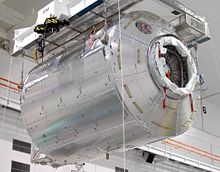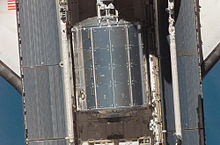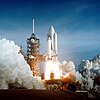STS-122
| Mission emblem | |||
|---|---|---|---|

|
|||
| Mission dates | |||
| Mission: | STS-122 | ||
| COSPAR-ID : | 2008-005A | ||
| Crew: | 7th | ||
| Begin: | February 7, 2008, 19:45:30 UTC | ||
| Starting place: | Kennedy Space Center , LC-39A | ||
| Space station: | ISS | ||
| Coupling: | February 9, 2008, 17:17 UTC | ||
| Decoupling: | February 18, 2008, 09:24 UTC | ||
| Duration on the ISS: | 8d 16h 07min | ||
| Number of EVA : | 3 | ||
| Landing: | February 20, 2008, 14:07:10 UTC | ||
| Landing place: | Kennedy Space Center, Lane 15 | ||
| Flight duration: | 12d 18h 21min 40s (until touchdown) |
||
| Earth orbits: | 202 | ||
| Rotation time : | 91.2 min | ||
| Apogee : | 339 km | ||
| Perigee : | 331 km | ||
| Covered track: | 8.5 million km | ||
| Payload: | Columbus space laboratory | ||
| Team photo | |||
 v. l. No. Leland Melvin, Stephen Frick, Rex Walheim, Leopold Eyharts, Stanley Love, Alan Poindexter, Hans Schlegel |
|||
| ◄ Before / After ► | |||
|
|||
STS-122 ( english S pace T ransportation S ystem) is the mission designation for a flight of the US Space Shuttle Atlantis (OV-104) of NASA . It was the 121st shuttle mission and the 29th flight of the space shuttle Atlantis. The 24th flight of a space shuttle to the International Space Station (ISS) took place from February 7th to 20th, 2008.
team
Shuttle crew
- Stephen Frick (2nd space flight), commander
- Alan Poindexter (1st space flight), pilot
- Stanley Love (1st spaceflight), mission specialist
- Rex Walheim (2nd space flight), mission specialist
- Leland Melvin (1st spaceflight), mission specialist
-
Hans Schlegel (2nd spaceflight), mission specialist ( ESA / Germany )

ISS crew outward flight
- Léopold Eyharts (2nd space flight), flight engineer ( ESA / France )
ISS crew return flight
- Daniel Tani (2nd space flight), flight engineer
Mission overview
With Columbus, STS-122 brought ESA's main contribution to the International Space Station . The European research module was connected to this during a space exit.
In addition, a nitrogen tank was replaced and equipment and consumables were transported to the station.
Preparations
After STS-117 landed on June 22, 2007 at Edwards Air Force Base , the Atlantis was flown back to the Kennedy Space Center (KSC), where it arrived on July 3. A day later, the space shuttle was driven into the Orbiter Processing Facility (OPF). There she was prepared for her next assignment.
On September 14, the mission's external tank arrived at KSC and was taken to the Vehicle Assembly Building (VAB). There it was checked and prepared for the start.
Due to the delays in the previous mission ( STS-120 ), it had been feared that this would also affect STS-122. For a long time, only one assembly bay was available due to renovation work on the VAB gates. That would have meant that the start setup could only be started after the Discovery had left the VAB. The start period in December was only one week. NASA therefore accelerated the work on the gates, so that on September 20 a launch platform for the Atlantis could drive into the VAB and there were no delays with STS-122.
Construction of the two solid rocket rockets began on September 26 and was completed on October 14. During this time, the previously dismantled main engines were reinstalled in the orbiter. The external tank was connected to the boosters on October 19th.
The transport of the Atlantis from the OPF to the VAB took place on November 3rd. In it, the orbiter was connected to the external tank and the boosters. One week later, on November 10th, the six-hour rollout to launch pad 39A took place. The next day the Columbus module, which had already been transported to the ramp in the payload container on November 7th, was loaded into the cargo hold of the Atlantis.
On November 19 and 20, the astronauts completed the so-called Terminal Countdown Demonstration Test. This TCDT exercise played through the final hours of the countdown to give the team a chance to familiarize themselves with the process. The TCDT ended with a simulated aborted start.
The readiness check was held on November 30th at KSC. The NASA officials advised on the readiness of all systems of the space shuttle to start. The panel unanimously declared that STS-122 was ready to go. At the same time, the preliminary start date was confirmed on December 6th.
On December 4th the countdown to the mission began. The team had arrived at KSC a few hours earlier.
Sensor problems during the first start attempts
On December 6, 2007, the first attempt to start was made. Filling of the external tank began around 12:00 UTC . Shortly thereafter, a problem with the ECO sensors ( Engine CutOff sensor , low level cut-off sensors ) was discovered. Two of the four fuel sensors were not working. The start attempt was aborted at 14:57 UTC, after which the external tank was emptied again. NASA analyzed the problem that had already delayed the launch of the STS-114 and STS-115 . After these incidents, the wiring was revised and it was believed that the problem was solved. First, a shift of 24 hours was announced (December 7, 2007 at 21:09 UTC). The launch was later postponed for two more days to December 9 at 20:21 UTC. However, the starting rules have been tightened - all four ECO sensors should work properly during the countdown.
Shortly after refueling started on December 9th, one of the ECO sensors again malfunctioned. Therefore the attempt to take off at 12:24 UTC was canceled. After further investigation, the tank was emptied. NASA later announced that the start should take place on January 2, 2008 at the earliest, in order to have more time to investigate the problem with the ECO sensors more closely.
The crew flew back to the Johnson Space Center in Houston on December 10th for more training and Christmas with their families. In the opinion of Wayne Hale , Director of the Shuttle Program, there is a possibility that none of the Shuttle program flights were made with properly functioning ECO sensors.
On December 13, the start was postponed again by eight days to January 10. Wayne Hale said the idea was to enable technicians to spend a little more time with their families.
Refueling test
To track down the strange behavior of the sensors, NASA carried out a tank test on December 18. For this purpose, the wiring of the ECO sensors between the external tank and the orbiter was connected to additional diagnostic equipment. The evaluation of the data from the launch attempts on December 6th and 9th showed that the cause is not to be found in the sensors themselves, but rather in the cable harnesses that lead from the tank to an electronic unit in the stern of the ferry. During refueling, when two sensors failed, the electrical resistance in each cable was measured accurately. This made it possible to determine at which point the pipe system was defective. Wayne Hale stated after testing that the cause of the wrong ECO probe readings was actually in the wiring. By refueling with liquid hydrogen, the cable bushing in the outer wall of the tank could warp in such a way that the electronic contact between the cable connections and the bushing could be impaired.
Before the Christmas holidays, work began to remove insulating foam from the relevant point on the tank. On December 27, NASA announced that it would remove the cable gland and send it to the Marshall Space Flight Center for further investigation . Furthermore, a replacement device was prepared for installation in which the connections on the outer wall were soldered directly to the strands of the cable to the on-board electronics. The further procedure depends on the results. Therefore, no new start date was given for the time being. On January 3rd, it was announced that the new implementation would be installed on January 10th and that it could not start until January 24th at the earliest. According to John Shannon, assistant director of the shuttle program, a start date in the first week of February is more likely.
NASA announced on January 11th that the new launch date was set for February 7th. Russia had previously brought the start of the next Progress freighter two days forward to February 5th. This ensured that not two spaceships arrive at the space station at the same time. The appointment was confirmed on January 30th after another flight readiness review, but another problem with the radiators was observed. A transfer line appears to show old age problems, which were investigated, but the problem was resolved.
Mission history
begin
Shortly after the crew arrived at KSC on February 4, the countdown began at 22:00 UTC. Due to a bad weather front, NASA assumed a probability of only 30 percent that the weather would allow a start on February 7th.
On February 7, around 0:20 UTC, the RSS work platform was swiveled away from the Atlantis. Filling of the external tank began later at 10:30 UTC . Then the ECO sensors were tested, which worked perfectly. The weather continued to worry the teams. There were rain showers 13 kilometers away from the Kennedy Space Center . The start could only be allowed as long as no rain falls within a radius of 30 kilometers. The clouds also did not meet the permissible weather criteria. Later, however, the start probability increased to 40 percent.
The crew arrived at the launch pad at 16:15 UTC . Thereafter the weather improved noticeably and the Atlantis was able to take off from launch pad 39A at 19:45:30 UTC, exactly seven years after the shuttle with STS-98 with the Destiny laboratory module took off to the ISS. After the two boosters were thrown off two minutes after take- off, the main engines were switched off and the external tank was cut off at 19:54 UTC .
Inspection and coupling
On the second day of the flight (February 8th) the heat shield was checked with the Orbiter Boom Sensor System . This was previously connected to the shuttle's robot arm . Among other things, the wings and the nose were scanned. Furthermore, preparations were made for docking with the space station and the equipment for the spacecraft was checked.
On the third day of flight (February 9th) the Atlantis reached the ISS. Before docking, the Atlantis carried out the so-called rendezvous pitch maneuver . This complete rotation about the pitch axis gave the ISS crew the opportunity to photograph the orbiter's heat shield . Particular attention was paid to the right OMS gondola, on which, similar to the STS-117 , a heat protection mat had come off.
The coupling to the space station took place at 17:17 UTC. It was the first time that a shuttle docked at the Harmony module. After the pressure equalization, the hatches between the ISS and the space shuttle were opened at 18:40 UTC and the crews greeted each other. Afterwards, equipment for the three EVAs was brought into the Quest airlock.
A little later it became known that the first external flight mission (EVA) would be postponed by one day and would be carried out by Stan Love instead of Hans Schlegel together with Rex Walheim. The reason for this were abnormal body measurements at Hans Schlegel. Simultaneously with the EVA postponement, the Atlantis mission was extended by one day. The replacement of the Soyuz seats was brought forward, so that from that point on Dan Tani belonged to STS-122 and Léopold Eyharts to Expedition 16.
Working on the ISS
After the wake-up call on the fourth day of the mission, it turned out that Schlegel had no health problem. Schlegel then received clearance to participate in the second spacecraft mission. After the postponement of the spacecraft, the flight day (February 10th) was rescheduled at short notice. The freight transfer work was carried out and a more detailed inspection of the heat protection mat was scheduled. In addition, the preparations for the exit, which were canceled the day before, continued. In the evening, Rex Walheim and Stanley Love went to the Quest airlock for a "campout" .
On February 11 at 14:13 UTC, Rex Walheim and Stanley Love began the first of three spacecraft missions, planned for six and a half hours. A coupling adapter was attached to Columbus so that the laboratory could be lifted out of the hold of the ferry with the help of the ISS robot arm . They then prepared the nitrogen tank for its replacement at the second EVA. At the same time Columbus was lifted out of the cargo bay and brought into position in front of the starboard docking nozzle on Harmony. There the module was assembled by the two “dropouts” at 21:44 UTC. The exit ended after seven hours and 58 minutes at 22:11 UTC.
February 12th was mainly used for the internal construction of Columbus. First a pressure tightness test was carried out, later at 14:08 UTC the hatches to Columbus were opened. Immediately afterwards, the module was connected to the circuit of the station, the lights switched on and the ventilation activated. Transfer activities, preparations for the next exit and several interviews also took place.
The second spacecraft began on February 13 at 14:27 UTC. The aim of the exit carried out by Walheim and Schlegel was to replace the P1 nitrogen tank, which is part of the station's cooling system. Since this work was done very quickly, two more tasks could be performed. Transport brackets on Columbus were covered and the rubble shield on Destiny was inspected. Schlegel was the second German after Thomas Reiter to conduct an EVA. The exit ended at 21:12 UTC after six hours and 45 minutes. The mission was also extended by one more day.
On February 14th, preparations were made for the third space exit the next day. Cargo transfer tasks continued. In addition, Chancellor Angela Merkel , ESA Director General Jean-Jacques Dordain and Thomas Reiter spoke on the phone with Hans Schlegel, Dan Tani, Peggy Whitson, Juri Malentschenko and Léopold Eyharts. In the evening, Walheim and Love went to the Quest airlock for a campout.
During the third field mission on February 15, two external payloads were attached to Columbus. Astronauts Walheim and Love began their seven and a half hour mission at 13:07 UTC. In addition to the installation of Solar and EuTEF , the defective CMG control gyroscope (Control Moment Gyroscope) was stowed in the loading bay of the Atlantis for the return to earth. The CMG failed in October 2006 and was replaced with a spare part during STS-118 in August 2007. Then they examined a defective handle on Quest, which was probably the cause of damage to the astronaut's gloves. The exit ended at 20:32 UTC.
On February 17th, freight transfers took place. Then the two crews said goodbye to each other. At around 17:30 UTC the hatches between the space station and Atlantis were closed.
return
On February 18 at 9:24 UTC, the two spacecraft separated. After undocking, the Atlantis flew around the ISS and took photos and video recordings of the current configuration. The heat shield was checked again during the day.
On February 20, at 12:32 UTC, flight control decided to use the first of the four landing options of the day. Half an hour later the brakes were ignited to leave the earth orbit. After 202 orbits of the earth, the space shuttle touched down with the main landing gear on runway 15 of the Shuttle Landing Facility of the KSC at 14:07:10 UTC .
After the orbiter had cooled down and carried out various tests, the crew switched to a crew transporter that had driven in front of the hatch about 45 minutes after landing. At 15:45 UTC, the team left to examine the outer condition of the space shuttle. Only flight engineer Daniel Tani remained in the transporter, as he had to get used to the gravity again after four months in weightlessness as part of the ISS expedition 16 .
A few hours later, the Atlantis was towed into the Orbiter Processing Facility to prepare for the Hubble STS-125 maintenance mission .
Web links
- NASA: Official Mission Site (English)
- Video summary with comments of the crew (English)
- Space Science Journal: Mission STS-122
- Space Science Journal: Description of the ECO sensors
swell
- ↑ NASA News: Space Shuttle Atlantis Arrives at Launch Pad , November 10, 2007 (English)
- ↑ NASA News: NASA Gives "Go" for Space Shuttle Launch on Dec. 6 , November 30, 2007 (English)
- ↑ NASA News: NASA Targets Space Shuttle Atlantis Launch on Jan. 2 , December 9, 2007 (English)
- ↑ NASA News: NASA Targets Space Shuttle Atlantis Launch on Jan. 10 , December 13, 2007 (English)
- ↑ SPACE.com: NASA Sets Plan for Shuttle Sensor Fix , December 27, 2007 (English)
- ↑ NASA News: NASA Announces Space Shuttle Launch Targets , January 11, 2008 (English)
- ↑ NASA News: NASA Gives 'Go' for Space Shuttle Launch , January 30, 2008 (English)
- ↑ SPACE.com: NASA Delays Spacewalk Because of Medical Issue , February 9, 2008 (English)
- ↑ tagesschau.de: German astronaut fit for outdoor use (tagesschau.de archive)
- ↑ NASA News: Shuttle Atlantis Crew Returns Home After Successful Mission , February 20, 2008 (English)










